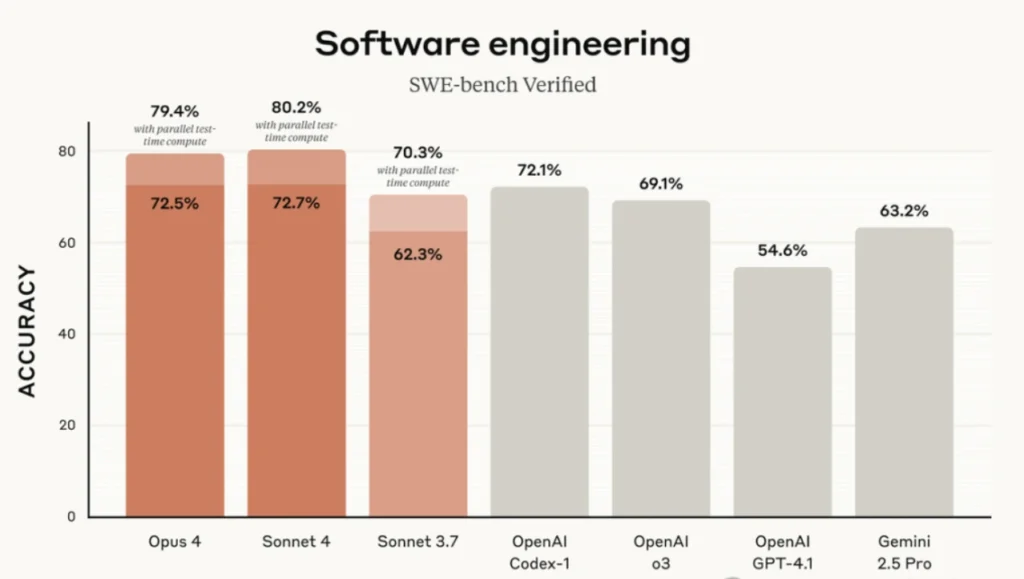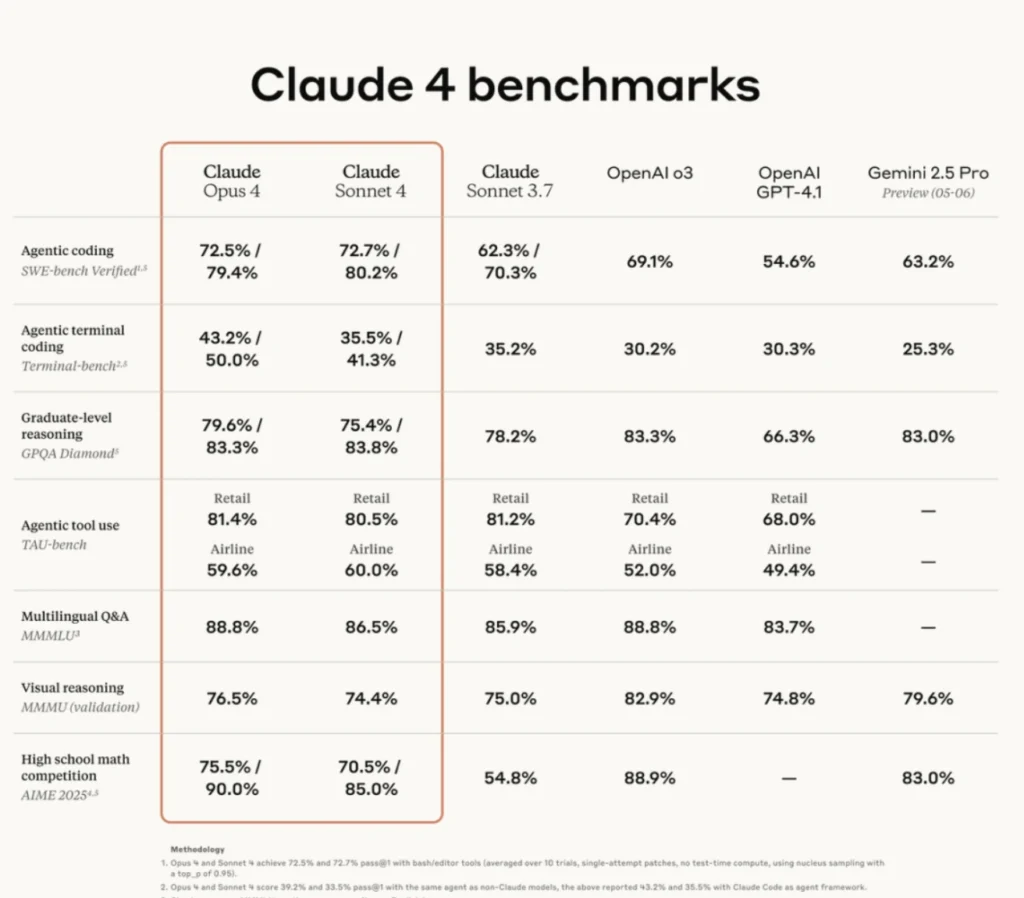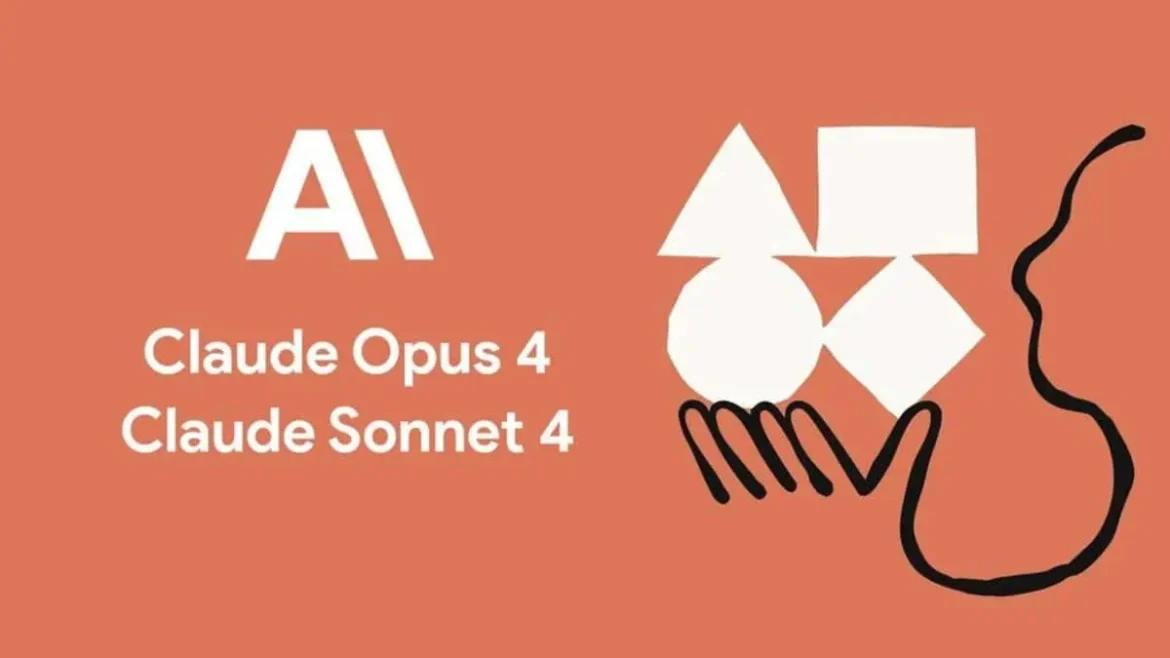Claude 4 Released!
Anthropic dropped a bombshell late last night with the official release of the Claude 4 family, featuring Claude Opus 4 and Claude Sonnet 4. These two versions are set to redefine the landscape of programming AI, pushing the existing boundaries significantly higher. This isn’t just an incremental update; it’s a comprehensive overhaul of what AI can achieve in coding.
Unveiling the Claude 4 Family: Power and Versatility
The Claude 4 series introduces models designed for different needs but united by a common strength: exceptional coding capabilities that aim to surpass current competitors.

Claude Opus 4: The Programming Powerhouse
Anthropic has officially named Claude Opus 4 the “world’s best programming model.” Its credentials include an impressive 72.5% score on the SWE-bench Verified, a benchmark renowned for measuring a model’s ability to handle real-world software engineering tasks. This indicates Opus 4’s proficiency in tackling complex problems inherent in actual software development.
Further highlighting its capabilities, Claude Opus 4 achieved a 43.2% score on Terminal-bench. It can operate continuously for hours on demanding tasks while maintaining focus and high performance. For instance, Rakuten confirmed Opus 4’s stability and prowess by having it independently refactor a complex open-source project for a full seven hours without performance degradation.
Claude Sonnet 4: The Versatile Performer
While Claude Sonnet 4 is presented as the “everyday use version,” its power is substantial. It demonstrates marked improvements in programming and reasoning over its predecessor, Sonnet 3.7. Notably, Sonnet 4 scored 72.7% on SWE-bench, outperforming many existing models in the market.
Claude 4 Core Innovations: Hybrid Architecture & Advanced Reasoning
Both Opus 4 and Sonnet 4 utilize a sophisticated hybrid architecture. This design offers two distinct operational modes:
- Near-instantaneous responses for quick queries.
- A “thinking mode” that allows for extended, deep-thinking reasoning and in-depth analysis when confronted with complex problems, much like a human expert.
Remarkably, during this “thinking mode,” the models can employ tools such as web search, creating a dynamic “think-search-rethink” workflow. This integration of advanced reasoning with practical tool use elevates their capabilities to an entirely new level.
Industry Acclaim and User Excitement
The launch has been met with positive feedback from businesses already leveraging Claude:
- Cursor hailed Opus 4 as a significant breakthrough in programming, particularly praising its enhanced understanding of complex codebases.
- GitHub announced its decision to use Sonnet 4 as the foundational model for its popular Copilot service.
- Replit reported “dramatic improvements” in the model’s capacity for handling intricate modifications across multiple files.
- Rakuten‘s seven-hour refactoring test further validated Opus 4’s robust and stable performance.
The enthusiasm extends to the wider user community on platforms like X. User Christian Yun (@christiankyun) likened the release to a major event in the gaming world:
The AI world’s GTA6 is finally here!
kitze (@thekitze) is already eager to use Sonnet 4 to refactor React components:
Can’t wait to reinvent the universe from scratch to refactor my React components with Sonnet 4.
However, some skepticism has surfaced. voicesz (@voicesz_) expressed skepticism about the benchmark results:
These guys want us to believe it’s worse than o3 at high school math but better at programming? Wake up.
Claude 4 vs. The Titans: Charting the New Programming Frontier
The declaration of Claude Opus 4 as the “world’s best programming model” and Sonnet 4’s impressive SWE-bench score inevitably draw comparisons with other leading AI models in the fiercely competitive AI landscape, where names like OpenAI’s GPT series and Google’s Gemini models are prominent. While direct, contemporaneous head-to-head benchmark results against the very latest iterations aren’t detailed in this announcement, Claude 4’s claimed prowess positions them as formidable contenders.
Programming AI Models Comparison Table
| Feature / Model | Claude Opus 4 | Gemini 2.5 Pro | O3 (OpenAI) |
| Release Date | May 2025 | Feb 2025 | April 2024 |
| Benchmark (SWE-bench) | 72.5% | ~63% (based on available public estimates) | ~64% (GPT-4 Turbo estimates) |
| Terminal-bench | 43.2% | Not disclosed | Not disclosed |
| Tool Use | Integrated (web search, parallel tools, memory files) | Integrated (web browsing and code execution) | Tool use via Code Interpreter & plugins |
| “Thinking Mode” | Yes – dynamic deep-reasoning mode | Not explicitly detailed | Available via AutoGPT / multi-step planning models |
| Long-term Memory | Persistent memory via “memory files” | Episodic memory features (in development) | Limited memory; contextual up to ~128k tokens (GPT-4 Turbo) |
| Multi-file Editing | Yes (noted by Replit) | Partial | Yes, with GPT-4 Turbo |
| Coding Use Case | Refactoring, debugging, documentation, prototyping | Coding assistant, general web-based reasoning | Code completion, debugging, simulation, AutoGPT tasks |
| Pricing (API) | $15 input / $75 output (per million tokens) | Unknown | $10 input / $30 output (GPT-4 Turbo) |
| Primary Interface | Anthropic API, Claude.ai, Amazon Bedrock, Google Vertex AI | Google Cloud, Gemini Pro APIs | OpenAI API, ChatGPT, Azure OpenAI |
| Developer Tools Support | Terminals, VS Code, JetBrains, GitHub Actions | Android Studio, Colab integration | VS Code, GitHub Copilot, OpenAI tools |
⚠️ Note: Benchmark numbers for Gemini 2.5 Pro and O3 are approximations, as exact benchmark test scores are not always published or use varying standards.

Practical Impact: Use Cases and Considerations of Claude 4
The capabilities described for Claude 4 suggest a wide array of applications beyond initial examples.
1.Expanding Software Development Capabilities
While we highlight Claude Opus 4’s refactoring prowess and Sonnet 4’s integration into GitHub Copilot, their “significant improvements in programming and reasoning ability” point towards broader utility in:
- Complex Debugging: The “deep-thinking reasoning” mode could assist in identifying and resolving intricate bugs.
- Automated Documentation: Understanding complex codebases could be leveraged to generate or update technical documentation.
- Test Case Generation: The ability to understand requirements and code logic could facilitate creating comprehensive tests.
- Architectural Design and Prototyping: Claude 4 could assist in designing software components or drafting initial architectural skeletons.
- Multi-file Modifications: As noted by Replit, handling changes across numerous project files is a key strength.
2.Navigating Potential Boundaries
As with any advanced AI, users should consider its limitations. While memory is “dramatically improved” with “memory files,” specifics on context window size versus long-term memory persistence warrant practical exploration. Performance on highly niche programming languages or extremely large, proprietary codebases will also need case-by-case evaluation. The article also notes an improvement in preventing the use of “shortcuts or loopholes,” acknowledging this as an ongoing area of AI development.
Claude Code: Seamless Developer Integration
Coinciding with the model release, Claude Code has transitioned from a research preview to official availability. Developers can now directly utilize Claude within their preferred environments, including terminals, VS Code, and JetBrains IDEs. AI-generated modification suggestions will appear directly within code files, offering a seamless pair-programming experience.
Excitingly, Claude Code now supports GitHub Actions for background tasks. Developers can even mention @Claude Code in pull requests to address code review feedback or resolve CI errors.
A Leap in AI Memory
One of the most striking advancements in the Claude 4 models is their significantly enhanced memory capability. Through deep integration, these models maintain continuous focus and complete context. The Anthropic team shared experiences of working with Claude for entire days on extended research, application prototyping, and complex project planning.
When granted access to local files, Opus 4 proactively creates and maintains “memory files.” These files store crucial information, enabling the AI to retain continuity over long-term tasks and accumulate experiential knowledge. An illustrative example provided by Anthropic shows Opus 4 creating a “navigation guide” for itself while playing a Pokémon game, tracking progress and strategy. This feature allows the AI to learn and build upon past interactions, rather than starting anew with each conversation.
Importantly, these models also show improvements in avoiding the use of shortcuts or exploitable loopholes to complete tasks, with Claude 4 being 65% less likely to do so in agentic tasks compared to Sonnet 3.7.
Availability, Pricing, and the Road Ahead
The Claude 4 series is available immediately, with Sonnet 4 even accessible to free users. Paid subscribers can utilize both Opus 4 and Sonnet 4, along with the extended thinking features. API pricing remains consistent with previous versions:
- Opus 4: $15 per million input tokens / $75 per million output tokens.
- Sonnet 4: $3 per million input tokens / $15 per million output tokens.
These models are accessible via the Anthropic API, Amazon Bedrock, and Google Cloud Vertex AI.
The Unending AI Evolution
This launch signifies another major step in the ongoing AI programming arms race. The cycle of innovation continues relentlessly, with new “world’s most powerful” models frequently emerging. As the article notes, after O3 and Gemini 2.5 Pro, Claude 4 now takes the spotlight. The question remains: who will be next in this ceaseless competition?
❓FAQ
❓1. What is Claude 4 and how is it different from previous versions?
Claude 4 is the latest AI model family released by Anthropic, featuring Claude Opus 4 and Claude Sonnet 4. Unlike earlier versions, Claude 4 introduces a hybrid architecture with a unique “thinking mode” that enables extended reasoning for complex tasks. It also integrates memory files for continuity, shows major improvements in software engineering benchmarks, and supports advanced tool use like code execution and web search during problem-solving.
❓2. Is Claude 4 better than GPT-4 or Gemini 2.5 Pro for coding?
Yes, in many aspects of software engineering, Claude 4—especially Claude Opus 4—outperforms GPT-4 Turbo and Gemini 2.5 Pro. It achieved a 72.5% score on SWE-bench Verified, indicating superior accuracy in solving real GitHub issues, and 43.2% on Terminal-bench, which evaluates terminal command execution tasks. Additionally, its ability to maintain context over hours-long coding sessions and refactor large codebases makes it stand out.
❓3. Can I use Claude 4 for free?
Yes, Claude Sonnet 4 is available for free users on Anthropic’s platform. It offers powerful programming and reasoning abilities suitable for everyday use. For access to the more advanced Claude Opus 4, including features like extended memory and deeper reasoning, a paid Pro subscription is required. Both models are also available via the API, Amazon Bedrock, and Google Cloud Vertex AI.
❓4. What is “thinking mode” in Claude 4 and how does it work?
“Thinking mode” is a special operational state in Claude 4 where the model engages in deeper, multi-step reasoning. Instead of responding instantly, the model takes additional time to analyze complex problems—similar to how a human expert might pause and reflect. During this mode, Claude can use tools like web search, simulate code, and re-evaluate its responses in a “think-search-rethink” loop, resulting in more accurate and thoughtful outputs.
❓5. What are the main use cases of Claude 4 for developers?
Claude 4 excels in a wide range of programming use cases, including:
Complex codebase refactoring (used by companies like Rakuten and Cursor)
Multi-file code editing and project-wide modifications
Bug identification and debugging
Automated technical documentation
Test case generation
Pull request reviews and integration with GitHub Actions via Claude Code
Fine more AI news here !
🔗 Source of Information Links
Here are the likely sources based on the context and references in your article (you may verify and link to these):
- Anthropic’s Claude 4 Announcement Page
https://www.anthropic.com/news/claude-4 - GitHub Copilot Update with Claude Sonnet 4
https://github.blog or https://github.com/features/copilot - Cursor AI Praise for Claude 4
https://www.cursor.so/blog - Replit AI Announcements
https://replit.com/site/blog



